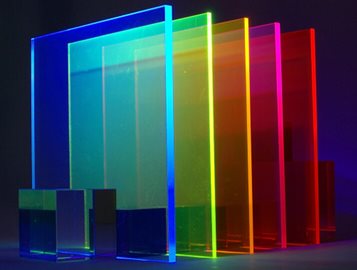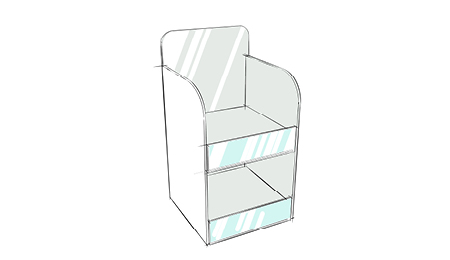Countertop display units, or CDU or CTU for short are very often positioned at retail checkouts or till-points and are designed to encourage shoppers to make last minute, impulse purchases before they pay for what they originally entered the shop to purchase; For example you will often see CTUs at till points in petrol forecourts offering confectionery, e-Cigarette products or gadgets that can be used in cars.
Away from the checkout, you will find countertop displays positioned in other locations such as shelves or merchandising display tables, an example of this would be costume jewellery within a retail clothing store.
So, with so many possible applications, how much do they actually cost….? Well, the truth is, that really depends on A LOT of different factors.
The cost of a countertop display unit depends on a number of factors including materials used, footprint, overall size, functional requirements, life expectancy and ultimately the quantity required.
Let’s explore factors that affect the price of a countertop retail display….
Materials vs Life Expectancy
The materials used to manufacture a countertop retail display unit are usually directly related to the life expectancy in-store that is needed. By their very nature countertop retail displays are positioned in high shopper traffic areas and typically there for shoppers to shop from themselves, so it is important to make sure the right materials are selected to make sure your display lives out its life successfully in-store.
Cardboard
For retail displays that are only required for a couple of months or so, then cardboard is probably the preferred choice. Ideal for short-term, temporary displays, cardboard is considerably cheaper than the likes of Foamex, acrylic, wood and metal.
If you need your countertop display to last a little longer, there are higher-spec cardboards available, but these will come at a higher cost. You can also add an extra element of robustness/strength to a cardboard retail display by applying a layer of gloss to provide extra protection, however this will impact on overall cost and also ultimately impact other factors such as sustainability and recyclability of the display at end of life.
Foamex
A slightly more expensive, but more robust material to create a retail countertop display, Foamex is an extremely versatile PVC foam board that can achieve a life expectancy of around 6 to 12 months in-store.

Acrylic
Ideal for when a longer life expectancy is needed, acrylic is widely used within the retail display manufacturing industry. More expensive than Foamex, acrylic is a much tougher material and when used correctly can produce a much more robust retail display than other materials.
Design and manufacturing are key when creating a countertop display from acrylic, as if not managed during display manufacturing currently it can become brittle and break.
Acrylic is a popular option for Designers, as it is available in a wide range of colours and styles.
One of the most popular for retail is edge-lit acrylic, as it can be used to create very eye-catching displays using natural light. Edge-lit acrylic typically adds around 10% to 15% over stock colours, but it can really make the difference when aiming to produce a stand-out display.

When designed with longevity in mind, acrylic countertop retail displays can prove to be a cost-effective option. But remember, it’s important that you work with a savvy display manufacturer.
Metal
As the strongest material to use for a retail countertop unit, metal can stay in very good condition for many years. Compared to the other materials mentioned in this article, metal could be considered to be the costliest material of them all. However due to how metal components are fabricated, in sufficient quantities metal can be more cost effective than the likes of acrylic, due to the amount of manual handling work involved with the manufacturing of an acrylic CTU.
Examples of costs per display type…
Large Cardboard Tray – Footprint 1330mm x 470mm, height 25mm (no back header), digitally printed graphics to front lip and 2 sides with gloss varnish applied – 130 units @ £24 each

Small Acrylic CTU – Footprint 160 x 160mm, height (with header card) 300mm, base plus 1 fixed Shelf, 2 x ticket strips, open front, header card and side panel vinyl applied graphics – 350 units @ £20 each

Large Acrylic CTU – Footprint 400 x 355mm, height (with header card) 750mm, 3 x removable shelves, closed front with flap doors for each shelf, 3 x ticket strips, storage area and tongs holder with side pocket for bags, header card and side panel direct print graphics – 100 units @ £110 each

Size matters…
The footprint of a retail display is the physical space that it takes up, in this case the space on the countertop. Typically, the countertop space in retail locations, especially near the checkout, is normally restricted as these areas are often shared with serving customers too.
The gem that all brands and retailers aim for, is to create a well-designed, eye-catching, easy-to-shop countertop display, only using a small footprint. But this is a fine art, or the pièce de resistance if you will.
Typically, the larger the CTU, the more materials you will need to make it and therefore the cost increases, so it is very important to consider all factors about what you want your CTU to offer customers before you start the design process.
Design considerations & enhancing your countertop retail display
There are a number of additional features that you can add to a CTU that will affect the overall cost of your display, but in turn make it more attractive to shoppers in-store.
Lighting
Adding lights to a retail display will make it much more visible to shoppers, as the use of light will cut above other in-store messages and stand out. There are many different ways to illuminate a retail display and the right solution will depend on the design, materials used in manufacturing and the power source required.
Printed Media and Point of Sale Graphics
Most countertop retail displays will be designed with space for branding or promotional message. After all, if you’re spending money getting a countertop display in-store, you’ll want to ensure you’re communicating the offer to customers.
The cost of printed graphics for your retail display will depend on the following factors; available space on the display for branding/promotional messaging, whether you need the artwork designed for you or whether you can do this in-house and then finally the print and application of graphics to the display.
Depending on the material you chose for your countertop display, there are different methods of producing graphics for your display, such as direct to substrate printing or vinyl wrapping.
Motion Detection
Imagine being able to disrupt the customer journey using a sensor that is built into a retail display. Using motion detection, a display unit can turn on lights, play a video, make a sound or trigger a particular fragrance when required.
This type of retail display enhancement has proved to be extremely successful in the past, creating a unique customer experience in-store and driving product purchases as more shoppers are stopped in their tracks and focussed on your display.
Digital screens
Innovation in technology over the years has led to an increase of digital screens being used in retail displays. The benefits of this include the ability to have more than one promotional message displayed in a video reel and also the ability to add sound.
Digital screens can be a costly addition to a retail display, as the initial outlay is in the purchase of the screens themselves. They will then need to be powered in-store, possibly restricting display locations. On the flip side, digital screens can be updated, so they can be used again and again, which some may call a wise investment.
Quantity: How many do you need…
What might seem obvious is that the more you need, the higher the cost will be. In reality, there’s a lot more that happens behind the scenes to calculate the overall cost of your displays.
Below is a guide as to how the price of a countertop retail display is calculated, including sourcing raw materials, manufacturing component parts, assembly, packaging and finally delivery.
Raw materials
The cost of raw materials will differ depending on the materials chosen to create your retail display. For example, if you are making a display from acrylic, then a minimum quantity order for that particular colour/style of acrylic will apply. Or if your display is to be made from a particular colour metal, a brand colour maybe, then there would be a cost to buy the paint to create your unique powder-coated metal.
Manufacturing
The cost of manufacturing will typically be included in the overall price. This usually includes technical drawings, machinery setup costs and the time, use of machinery and manpower used during production.
Prototypes
Often, it is possible to see a prototype of your countertop retail display before going into full production. In fact, any reputable manufacturer will give you this option.
Prototypes can cost more than the unit cost you have been quoted for your complete retail display order. This is because prototypes are often produced before committing to purchasing materials, so quantities of scale do not apply to raw materials and setup costs still apply as explored the manufacturing section above.
You can find out more about Prototypes in our articles: What is a prototype and why do I need one? and Why do prototypes cost more than the unit price for larger quantities?
Assembly
The cost to assemble your retail display will ultimately depend on its design and complexity.
For high production quantities, it is very common for an assembly line to be used, where individuals are responsible for assembling certain parts of each display unit, such as shelves, promotional messaging and merchandising.
Packaging
As most retail displays are bespoke solutions, packaging them also needs to be uniquely designed to ensure they are safely secured and protected during transit.
The good news is, the materials used to package your retail displays are none too different from what you would expect, such as bubble wrap, polystyrene and cardboard, which are all not too expensive.
It’s also important to remember that your manufacturer should have the in-house capability to create unique packaging for your display – they’re the experts, after all!
Delivery
The final part of the process is delivery, which might be to a central warehouse or individual store locations. No prizes to which is more cost-effective.
You got it! The cost of delivering to one location will prove to be significantly more cost-effective than to multiple locations, but this really depends on whether you have your own distribution network or speed required to get the retail display into stores.
A top tip when considering how best to get your display delivered is to think about the journey it will go through via different courier methods. For example, sending via a direct same day delivery service rather than an overnight for delivery next day means that it will be handled by less people and reduce the risk of loss or breakages – even though the initial cost of an overnight delivery is cheaper.
Summary
In this article, we’ve covered a number of factors to consider when costing a countertop retail display unit. All of which your chosen display partner should help you to understand when designing and planning your next campaign.
We’d be happy to help! Three Point are the expert in specialist retail solutions. Our retail design specialists are ready to help you create an in-store display that delivers to your objectives and remains within budget.
Want to see what we can do? Take a look at our portfolio
Please contact our sales team on 01530 839777 or email info@threepd.co.uk
